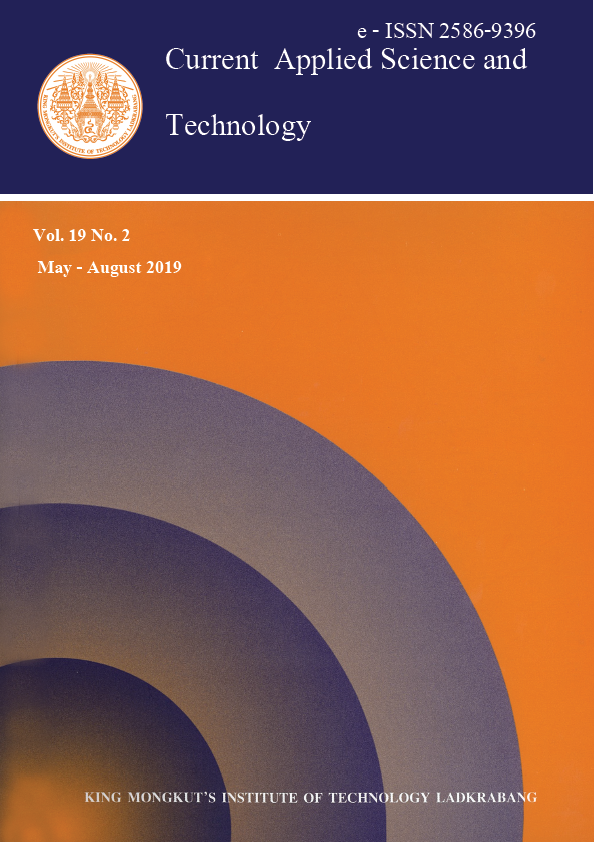The Lyapunov Analyses of MERS-Cov Transmission in Thailand
Main Article Content
Abstract
This work investigates the transmission model of MERS-Cov using SEIR model which divides the total human population into four subclasses: susceptible, exposed, infected and recovered. Two equilibrium points were exhibited: the disease-free equilibrium and the endemic equilibrium . The basic reproduction number was computed via the next generation method. Two types of global stability of these equilibrium points were investigated through the theory of Lyapunov. Specifically, the exponential stability was investigated using a square type Lyapunov candidate function; while the asymptotic stability was investigated through a Logarithm type Lyapunov candidate function. It is theoretically shown that, when the reproductive number is less than unity. The disease-free equilibrium state is globally asymptotically stable, and the endemic equilibrium state is globally asymptotically stable if the reproductive number is greater than unity. Numerical results with parameters obtained from the previous work also illustrates the global asymptotical stability of the MERS-Cov system. These results can further be used for the design of a controller that drives the MERS-Cov system and the effective control reproductive number is less than 1 so that the stability of the controlled system would be similar to that of the uncontrolled disease-free system.
Keywords: Global dynamical modeling method; Lyapunov function method; MERS; transmission model; basic reproductive number; next generation method; disease-free equilibrium state; endemic equilibrium state
*Corresponding author: E-mail: kppuntan@kmitl.ac.th
Article Details
Copyright Transfer Statement
The copyright of this article is transferred to Current Applied Science and Technology journal with effect if and when the article is accepted for publication. The copyright transfer covers the exclusive right to reproduce and distribute the article, including reprints, translations, photographic reproductions, electronic form (offline, online) or any other reproductions of similar nature.
The author warrants that this contribution is original and that he/she has full power to make this grant. The author signs for and accepts responsibility for releasing this material on behalf of any and all co-authors.
Here is the link for download: Copyright transfer form.pdf
References
Hemida, M.G., Elmoslemany, A., Al-Hizab, F., Alnaeem, A., Almathen, F., Faye, B., Chu, D.K.W., Perera, R.A.P.M and Peiris, M., 2017. Dromedary camels and the transmission of Middle East respiratory syndrome coronavirus (MERS-CoV). Transboundary and Emerging Diseases, 64(2) 344-353.
Ministry of Public Health, 2016. Middle East Respiratory Syndrome. [online] Available at: http://203.157.41.165/beid_2014/sites/default/files/situation_mers_30.9.60.pdf
World Health Organization, 2017. Middle East respiratory syndrome coronavirus (MERS-CoV) -United Arab Emirates. [online] Available at: http://www. who.int/csr/don/ 21-september-2017-mers-uae/en/
Ministry of Public Health, 2016. Middle East Respiratory Syndrome. [online] Available at: http://203.157.41.165/beid_2014/sites/default/files/situation_mers_151159.pdf
Aburizaiza, A.S., Mattes, F.M., Azhar, E.I., Hassan, A.M., Memish, Z.A., Muth, D., Meyer, B., Lattwein, E., Müller, M.A. and Drosten, C., 2014. Investigation of anti-middle east respiratory syndrome antibodies in blood donors and slaughterhouse workers in Jeddah and Makkah, Saudi Arabia, Fall 2012. The Journal of Infectious Diseases, 209 (2), 243-246.
Chowell, G., Blumberg, S., Simonsen, L., Miller, M.A. and Viboud, C., 2014. Synthesizing data and models for the spread of MERS-CoV, 2013: Key role of index cases and hospital transmission. Epidemics, 9, 40-51.
Kim, Y., Lee, S., Chu, C., Choe, S., Hong, S. and Shin, Y., 2016. The characteristics of Middle Eastern respiratory syndrome coronavirus transmission dynamics in South Korea. Osong Public Health and Research perspectives, doi:10.1016/j.phrp.2016.01.001
van den Driessche, P. and Watmough, J., 2002. Reproduction numbers and sub-threshold endemic equilibria for compartmental models of disease transmission. Mathematical Biosciences, 180, 29-48.
Heffernan, J.M., Smith R.J. and Wahl, L.M., 2005. Perspectives on the basic reproduction ratio. Journal of the Royal Society Interface, 2, 281-293.
LaSalle, J.P., 1976. The Stability of Dynamical Systems. Philadelphia: Society for Industrial and Applied Mathematics.
Lamwong, J., Tang, I.M. and Pongsumpun, P., 2018. Mers model of Thai and South Korean population. Current Applied. Science and Technology, 18(1), 45-57.


